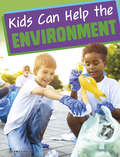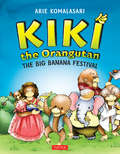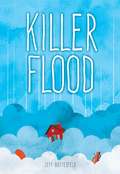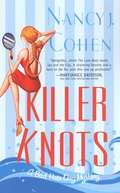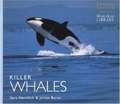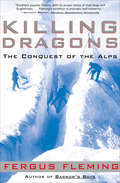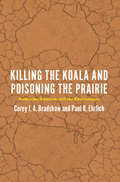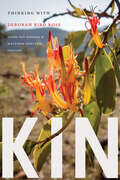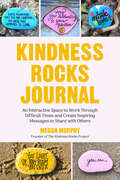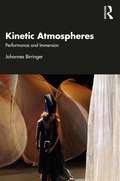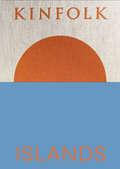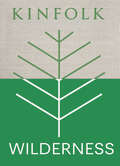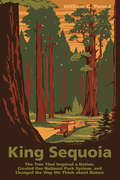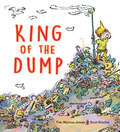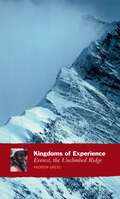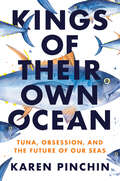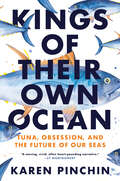- Table View
- List View
Kids Camp!: Activities for the Backyard or Wilderness
by Laurie Carlson Judith DammelActivities to help young campers build an awareness of the environment, learn about insect and animal behavior, boost their self-esteem, and learn the basics for fun, successful camping.
Kids Can Help the Environment (Kids Can Help)
by Emily RaijMake the world a cleaner, healthier place to live! This book is full of ideas and projects readers can put into action to help the environment.
Kiebitzinseln in der Agrarlandschaft: Von der Störstelle zum Habitat (essentials)
by Jan-Uwe SchmidtIn diesem essential beschreibt Jan-Uwe Schmidt, wie durch Kiebitzinseln nicht nur dem Kiebitz geholfen wird, sondern auch andere Tier- und Pflanzenarten profitieren k#65533;nnen. Durch j#65533;hrliche Anlage einer Schwarzbrache mit mindestens 2 Hektar Gr#65533;#65533;e lassen sich Nassstellen leicht als Kiebitzbrutplatz einrichten. Landwirte erh#65533;hen so die Nachhaltigkeit der Landnutzung und schaffen au#65533;erdem einen sicheren Erl#65533;s aus der Verg#65533;tung der Agrarumweltma#65533;nahme. Dieses essential gibt praktische Hinweise zur Planung und Anlage von Kiebitzinseln mithilfe von Luftbildern.
Kiki the Orangutan
by Arie KomalasariKiki is bored. And hungry! His family is busy, he wants to play, but no one has the time. So Kiki goes for a walk...and that's where all the trouble begins!Kiki the Orangutan is the charming tale of a naughty but good-natured orangutan who simply cannot resist stealing a bunch of ripe bananas from his neighbor's tree. After he has eaten them, however, he finds out that the bananas were going to be used to make banana bread-his favorite food-for the Banana Festival the next day. Now his poor neighbor has no bananas left to make any bread! Can Kiki make up for his actions and find a new bunch of bananas in time?
Kill the Cowboy: A Battle of Mythology in the New West
by Sharman Apt RussellOn ranching, environmentalism, and change -- life and thought in the West, seen through the eyes of some of the players.
Kill-site
by Tim LilburnBy the winner of the Saskatchewan Book Award for Best Book of the YearTo his virtuoso collection of new poems, Tim Lilburn brings a philosopher’s mind and the eyes and ears of a marsh hawk. This series of earthy meditations makes the strange familiar and the familiar strange. Lilburn’s close study of goldenrod, an ice sheet, or night opens into surprising interior and subterranean worlds. Pythagoras lurks within the poplars, Socrates in stones, people fly below the ground. Elsewhere, the human presence of motels and beer parlours is ominous. Kill-site is an exploration of a human’s animal nature. Lilburn invites the reader to: “Go below the small things… then / walk inside them and you have their kindness.” Though a natural progression from Lilburn’s last book, To the River, in Kill-site, the poet moves toward a greater understanding of the human, of sacrifice.
Killer Flood (Red Rhino)
by Jeff GottesfeldDan and Pete are excited to have a sleepover at Dan’s house while their parents are away. Their excitement turns to fear when the dam breaks and a killer flood smashes through town. The boys decide to stay put until they realize that Dan’s elderly neighbors may be in danger. When they reach the neighbors’ house, they find one of them near death. His lifesaving medicine is under water, and his wife is too old to make her way to town to get more. Both boys brave the flood to go find help. Hi-Lo Chapter Books for Children. This series of short novels was designed to engage a broad spectrum of struggling readers. No longer will upper-elementary students have to read material junior to their maturity and interests. Characters are age appropriate and come from diverse cultures and backgrounds. Science fiction, sports, paranormal, realistic life, historical fiction, and fantasy are just a few of the many genres. Books are no higher than a 1.5 reading level, with illustrations on every spread that support visual literacy and draw kids into the text.
Killer Knots
by Nancy J. CohenNancy J. Cohens Bad Hair Day mysteries are a cut above the rest--rich, full, and stylish. Now her beautician-sleuth Marla Shore puts down her curling iron and picks up her skills at detection when she books passage on a cruise ship with a killer aboard. . . Scissor-wielding sleuth Marla Shore is looking forward to a leisurely cruise with her fiancé Dalton Vail. Too bad Daltons teenage daughter and his parents are along for the ride. Instead of a seduction at sea, Marla is meeting the in-laws and hoping nothing goes too terribly wrong. Its a vain hope. A mysterious envelope stuck into her cabin door reads: I know what you did and I have what you want. If it hadnt been addressed to "Martha" Shore and obviously delivered by mistake, Marla might have feared it referred to the nudie pictures buried in her past. But that embarrassment would have been better than what the note does foretell: troubled waters lie dead ahead. So instead of cruise control, Marlas on high-alert, searching for the notes recipient before the cruise goes down the drain. If Marla doesnt find the culprit fast, this spunky stylist may end up with her own split end: caught between the devil and the deep blue sea. Praise for Nancy J. Cohens Bad Hair Day Mystery Series. . . "Plenty of humor, snappy repartee, and even a healthy helping of current events. " --Fort Myers News-Press "An amateur sleuth who can handle a curling iron and murder clues with aplomb. . . a stylish series. " --Fort Lauderdale Sun-Sentinel"Delightful. . . think The Love Boat meets Sex and the City. . . pick this one up posthaste!" --MaryJanice Davidson, New York Times bestselling author
Killer Whales (Worldlife Library)
by Sara Heimlich James BoranKiller whales are the supreme predators in the ocean. Today we are learning to respect them as intelligent and adaptable animals, rather than fear them as the loathsome creatures once imagined in legends. This revised and updated introduction to killer whales, or orcas, pieces together the latest information on how they live. We learn how they communicate and maintain well-established societies, with intricate family relationships, over long lifespans. We also learn about the environmental concerns that threaten killer whales. Illustrated by the world's best wildlife photographers, this book brings us face to face with these intriguing creatures. This is the revised edition.
Killing Bugs for Business and Beauty: Canada’s Aerial War against Forest Pests, 1913–1930
by Mark KuhlbergKilling Bugs for Business and Beauty examines the beginning of Canada’s aerial war against forest insects and how a tiny handful of officials came to lead the world with a made-in-Canada solution to the problem. Shedding light on a largely forgotten chapter in Canadian environmental history, Mark Kuhlberg explores the theme of nature and its agency. The book highlights the shared impulses that often drove both the harvesters and the preservers of trees, and the acute dangers inherent in allowing emotional appeals instead of logic to drive environmental policy-making. It addresses both inter-governmental and intra-governmental relations, as well as pressure politics and lobbying. Including fascinating tales from Cape Breton Island, Muskoka, and Stanley Park, Killing Bugs for Business and Beauty clearly demonstrates how class, region, and commercial interest intersected to determine the location and timing of aerial bombings. At the core of this book about killing bugs is a story, infused with innovation and heroism, of the various conflicts that complicate how we worship wilderness.
Killing Dragons: The Conquest of the Alps
by Fergus FlemingIn a riveting narrative of daredevils and eccentrics, Fergus Fleming gives us the breathtaking story of some of history's greatest explorers as they conquer the soaring peaks of the Alps. Fleming recounts the incredible exploits of the men whose centuries-old fear of the mountain range turned quickly to curiosity, then to obsession, as they explored Europe's frozen wilderness. In the late eighteenth century French and Swiss scientists became interested in the Alps as a research destination, but in the 1850s the focus changed: the icy mountains now offered an all-out competition for British climbers who wanted to conquer ever higher and more impossible heights, and explorers fought each other on the peaks and in the press, entertaining a vast public smitten with their bravery, delighted by their personal animosities, and horrified by the disasters that befell them. "...excellent popular history, with its proper share of mad dogs and Englishmen....Fleming's rendition is dramatic and masterful." — Anthony Brandt, National Geographic Adventure
Killing the Koala and Poisoning the Prairie: Australia, America, and the Environment
by Paul R. Ehrlich Corey J. A. BradshawThough separated by thousands of miles, the United States and Australia have much in common. Geographically both countries are expansive--the United States is the fourth largest in land mass and Australia the sixth--and both possess a vast amount of natural biodiversity. At the same time, both nations are on a crash course toward environmental destruction. Highly developed super consumers with enormous energy footprints and high rates of greenhouse-gas emissions, they are two of the biggest drivers of climate change per capita. As renowned ecologists Corey J. A. Bradshaw and Paul R. Ehrlich make clear in Killing the Koala and Poisoning the Prairie, both of these countries must confront the urgent question of how to stem this devastation and turn back from the brink. In this book, Bradshaw and Ehrlich provide a spirited exploration of the ways in which the United States and Australia can learn from their shared problems and combine their most successful solutions in order to find and develop new resources, lower energy consumption and waste, and grapple with the dynamic effects of climate change. Peppering the book with humor, irreverence, and extensive scientific knowledge, the authors examine how residents of both countries have irrevocably altered their natural environments, detailing the most pressing ecological issues of our time, including the continuing resource depletion caused by overpopulation. They then turn their discussion to the politics behind the failures of environmental policies in both nations and offer a blueprint for what must be dramatically changed to prevent worsening the environmental crisis. Although focused on two nations, Killing the Koala and Poisoning the Prairie clearly has global implications--the problems facing the United States and Australia are not theirs alone, and the solutions to come will benefit by being crafted in coalition. This book provides a vital opportunity to learn from both countries' leading environmental thinkers and to heed their call for a way forward together.
Killing the Koala and Poisoning the Prairie: Australia, America, and the Environment
by Paul R. Ehrlich Corey J. BradshawThough separated by thousands of miles, the United States and Australia have much in common. Geographically both countries are expansive—the United States is the fourth largest in land mass and Australia the sixth—and both possess a vast amount of natural biodiversity. At the same time, both nations are on a crash course toward environmental destruction. Highly developed super consumers with enormous energy footprints and high rates of greenhouse-gas emissions, they are two of the biggest drivers of climate change per capita. As renowned ecologists Corey J. A. Bradshaw and Paul R. Ehrlich make clear in Killing the Koala and Poisoning the Prairie, both of these countries must confront the urgent question of how to stem this devastation and turn back from the brink. In this book, Bradshaw and Ehrlich provide a spirited exploration of the ways in which the United States and Australia can learn from their shared problems and combine their most successful solutions in order to find and develop new resources, lower energy consumption and waste, and grapple with the dynamic effects of climate change. Peppering the book with humor, irreverence, and extensive scientific knowledge, the authors examine how residents of both countries have irrevocably altered their natural environments, detailing the most pressing ecological issues of our time, including the continuing resource depletion caused by overpopulation. They then turn their discussion to the politics behind the failures of environmental policies in both nations and offer a blueprint for what must be dramatically changed to prevent worsening the environmental crisis. Although focused on two nations, Killing the Koala and Poisoning the Prairie clearly has global implications—the problems facing the United States and Australia are not theirs alone, and the solutions to come will benefit by being crafted in coalition. This book provides a vital opportunity to learn from both countries’ leading environmental thinkers and to heed their call for a way forward together.
Kin: Thinking with Deborah Bird Rose
by Thom van Dooren and Matthew ChrulewThe contributors to Kin draw on the work of anthropologist Deborah Bird Rose (1946–2018), a foundational voice in environmental humanities, to examine the relationships of interdependence and obligation between human and nonhuman lives. Through a close engagement over many decades with the Aboriginal communities of Yarralin and Lingara in northern Australia, Rose’s work explored possibilities for entangled forms of social and environmental justice. She sought to bring the insights of her Indigenous teachers into dialogue with the humanities and the natural sciences to describe and passionately advocate for a world of kin grounded in a profound sense of the connectivities and relationships that hold us together. Kin’s contributors take up Rose’s conceptual frameworks, often pushing academic fields beyond their traditional objects and methods of study. Together, the essays do more than pay tribute to Rose’s scholarship; they extend her ideas and underscore her ongoing critical and ethical relevance for a world still enduring and resisting ecocide and genocide.Contributors. The Bawaka Collective, Matthew Chrulew, Colin Dayan, Linda Payi Ford, Donna Haraway, James Hatley, Owain Jones, Stephen Muecke, Kate Rigby, Catriona (Cate) Sandilands, Isabelle Stengers, Anna Tsing, Thom van Dooren, Kate Wright
Kindness Rocks Journal: An Interactive Space to Work Through Difficult Times and Create Inspiring Messages to Share with Others
by Megan Murphy#1 New Release in Rocks & Minerals — The Kindness Rocks Project, in Journal FormFans of Start with Gratitude, The Kindness Challenge and the Chicken Soup for the Soul books will love the Kindness Rocks Journal.A rock for each kindness: It all started with a single stone on a beach in Cape Cod and now spans the globe. The Kindness Rocks Project, founded by Megan Murphy, author of A Pebble for Your Thoughts, is based on the profound truth that one kind message at the right moment can change someone’s day, their outlook, and their whole life. This rock painting project has become an international grassroots movement! The messages on these positivity pebbles take many forms: gratitude, affirmations, encouragement, offers of hope—all signposts along the way for someone to find at exactly the right time.A Kindness and Gratitude Journal: Now more than ever, people are longing for kindness and connection. During these uncertain times, daily news reports focus on disturbing events of terrorism, gun violence, senseless murders, and political bickering. We are bombarded with images that evoke fear and hostility. The Kindness Rocks Journal provides a space to create a positive counteraction to all this negativity.Learn to be kinder to yourself and others: Sometimes, all it takes is just one simple positive message to change your perspective, and that is what this interactive writing journal aims to help you do.In the Kindness Rocks Journal, you will have space to:Respond to helpful journal prompts, affirmations, and quotesGrow through hard times with kindness and joyLearn how to paint an inspirational Kindness Rock and share it with others
Kinetic Atmospheres: Performance and Immersion
by Johannes BirringerThis book offers a sustained and deeply experiential pragmatic study of performance environments, here defined at unstable, emerging, and multisensational atmospheres, open to interactions and travels in augmented virtualities. Birringer’s writings challenge common assumptions about embodiment and the digital, exploring and refining artistic research into physical movement behavior, gesture, sensing perception, cognition, and trans-sensory hallucination. If landscapes are autobiographical, and atmospheres prompt us to enter blurred lines of a "forest knowledge," where light, shade, and darkness entangle us in foraging mediations of contaminated diversity, then such sensitization to elemental environments requires a focus on processual interaction. Provocative chapters probe various types of performance scenarios and immersive architectures of the real and the virtual. They break new ground in analyzing an extended choreographic – the building of hypersensorial scenographies that include a range of materialities as well as bodily and metabodily presences. Foregrounding his notion of kinetic atmospheres, the author intimates a technosomatic theory of dance, performance, and ritual processes, while engaging in a vivid cross-cultural dialogue with some of the leading digital and theatrical artists worldwide. This poetic meditation will be of great interest to students and scholars in theatre, performing arts as well as media arts practitioners, composers, programmers, and designers.
Kinfolk Islands (Kinfolk Adventures)
by John Burns&“Wanderlust inspiration.&”—GQ, The Best Gifts for Coworkers Join Kinfolk on a journey off the beaten track, to islands big and small, in this collection of eighteen new travel stories. Whether it&’s a tour of the otherworldly landscape of Socotra in Yemen or a hike into the old growth of a Japanese forest on Yakushima, each slow travel itinerary invites you to set sail at a pace that allows for true discovery and immersion. Filled with ideas and inspiration for where to escape, explore and unwind, Kinfolk Islands is full of vibrant photography, practical guidance and thoughtful reflections on why the idea of an island embodies so many of our travel fantasies. There are the charms of urban islands, including Montréal&’s beloved Mile End neighborhood. Truly unexpected destinations, like Hormuz, off the coast of Iran, with its psychedelic scenery and bohemian spirit. Italy&’s sun-soaked Ponza, perfect for languid afternoons. And of course some of the world&’s most beautiful beaches, from jungle-fringed Caribbean sands to rugged and remote Nordic shores. Believing that travel is as much a state of mind as an action or itinerary, Kinfolk celebrates a way of exploring our world that not only fosters thoughtful perspectives on the places we visit but also deepens our relationship with home once the journey is over.
Kinfolk Wilderness (Kinfolk Adventures)
by John BurnsThe second volume in the new Kinfolk trilogy (following Kinfolk Islands), which invites readers to celebrate the beauty and possibility to be found in the great outdoors.
King Charles: The Man, the Monarch, and the Future of Britain
by Robert JobsonAn exhaustive and revealing biography of Britain&’s new monarch, King Charles III, with fresh reporting by the journalist the Wall Street Journal dubbed &“the Godfather of royal reporting.&” With exclusive interviews and extensive research, King Charles delivers definitive insight into the extraordinary life of His Royal Highness, former Prince of Wales, as he takes the throne, a watershed moment in modern history and in the British monarchy.New York Times bestselling author Robert Jobson debunks the myths about the man who became king, going beyond banal, bogus media caricatures of Charles to tell his true story. Jobson—who has spent nearly thirty years chronicling the House of Windsor, and has met Charles on countless occasions—received unprecedented cooperation from Clarence House, what was the Prince&’s office, in writing this illuminating biography.King Charles divulges the full range of Charles&’s profoundly held political beliefs: the United Kingdom&’s special relationship to the United States, climate change, Brexit, and immigration—to ultimately portray the kind of monarch Charles III will be. Jobson taps a number of sources close to the now-King who have never spoken on the record before, plus members of the Royal Household who have served Charles during his decades of public life. This comprehensive profile also reveals the late Queen Elizabeth&’s plans to transition Charles to the throne; how at her insistence he already reads all government briefings; and why he feels it is his constitutional duty to relay his thoughts to ministers in his controversial &“black spider memos.&” Moreover, King Charles reveals the truth about Charles's deeply loving but occasionally volatile relationship with his second wife and chief supporter, Camilla. The result is an intriguing new portrait of a man who at last has become king.
King Sequoia: The Tree That Inspired a Nation, Created Our National Park System, and Changed the Way We Think about Nature (The Story Behind the Scenery Ser.)
by William TweedFrom a towering tree, one of California's preeminent naturalists unspools a history that echoes across generations and continents. Former park ranger William C. Tweed takes readers on a tour of the Big Trees in a narrative that travels deep into the Sierras, around the West, and all the way to New Zealand; and in doing so he explores the American public's evolving relationship with sequoias. It comes as no surprise that the groves in Yosemite and Calaveras were early tourist destinations, as this species that predated Christ and loomed over all the world's other trees was the embodiment of California's superlative, almost unbelievable appeal. When sequoias were threatened by logging interests, the feelings of horror that this desecration evoked in people catalyzed protection efforts; in a very direct way, this species inspired the Park Idea. And sequoias' influence doesn't end there: as science evolved to consider landscapes more holistically, sequoias were once again at the heart of this attitudinal shift. Featuring an entrancing cast of adventurers, researchers, politicians, and environmentalists, King Sequoia reveals how one tree species has transformed Americans' connection to the natural world.
King Sequoia: The Tree That Inspired a Nation, Created Our National Park System, and Changed the Way We Think about Nature (The\story Behind The Scenery Ser.)
by William C. TweedA naturist and historian for the National Parks Service offers a lively history of the giant sequoias of California and the love of nature they inspired. Former park ranger William C. Tweed takes readers on a tour of some of the world&’s largest and oldest trees in a narrative that travels deep into the Sierra Nevada mountains, across the American West, and all the way to New Zealand. Along the way, he explores the American public's evolving relationship with sequoias, also known simply and affectionately as Big Trees. It&’s no surprise that the sequoia groves of Yosemite and Calaveras were early tourist destinations. The species was the embodiment of California's superlative appeal. These giant redwoods were so beloved that special protections efforts sprang up to protect them from logging interests—and so began the notion of National Parks. Later, as science evolved to consider landscapes more holistically, sequoias once again played a major role in shaping this new perspective. Featuring a fascinating cast of adventurers, researchers, politicians, and environmentalists, King Sequoia reveals how one tree species transformed Americans' connection to the natural world.
King of the Dump
by Tim Wynne-JonesTeddy is the king of the dump! Teddy and his dad are going to the dump. At the rural waste management center, Teddy helps to sort the recyclables, using a garbage claw to rescue a missorted bottle, chasing scrap paper and watching (and hearing!) the compactor at work. “Got to make it as small as possible,” Dad says as they watch forklifts and bulldozers moving garbage into piles that stretch as far as the eye can see, “because there’s soooo much.” Finally, it’s time to visit the “As Is” store, where Teddy is sad to be leaving his beloved ride-on dog toy. Teddy is too big for the toy now, but will he be able to part with it? A fun, thoughtful story about big machinery, recycling and learning to let go of the things we no longer need. Key Text Features dialogue illustrations speech bubbles Correlates to the Common Core States Standards in English Language Arts: CCSS.ELA-LITERACY.RL.K.7 With prompting and support, describe the relationship between illustrations and the story in which they appear (e.g., what moment in a story an illustration depicts). CCSS.ELA-LITERACY.RL.1.4 Identify words and phrases in stories or poems that suggest feelings or appeal to the senses. CCSS.ELA-LITERACY.RL.1.7 Use illustrations and details in a story to describe its characters, setting, or events.
Kingdoms of Experience: Everest, the Unclimbed Ridge
by Andrew GreigA novice&’s tale of scaling Everest: &“Recommended for all armchair adventurers who have ever wondered what it would be like to climb in the Himalayas.&”—Geographical Magazine The last attempt to conquer Everest by the unclimbed northeast ridge had ended in failure and tragedy, with the deaths of two great climbers, Joe Tasker and Pete Boardman. Now, in March 1985, Mal Duff would lead a new expedition. Andrew Grieg and the others knew the risks as well as the excitement of the challenge—and in this extraordinary book, Greig chronicles not only the assault on the peak but also the complex relationships of nineteen very different personalities living together. &“Poet, novelist, and novice climber Greig's insightful account of the 1985 ascent of Everest's previously unclimbed northeast ridge provides an unusual perspective on the world of climbing. In comparison to many seasoned mountaineers, with their sometimes obsessive &‘diehard&’ drive, Greig possesses a refreshing sense of enthusiasm and innocence. His lack of experience allows him to describe with great intensity and detail the difficult tasks of climbing in a methodical step-by-step fashion, allowing readers to grasp the complex challenges. Greig is often able to step back and observe the goings-on, providing a detached analysis of the group and its dynamics. To complement his version of events, he also draws liberally from the diaries of the other participants. A unique addition to mountaineering literature with charming and distinct characteristics.&”—Library Journal
Kings of Their Own Ocean: Tuna, Obsession, and the Future of Our Seas
by Karen PinchinThis is a tale of human obsession, one intrepid tuna, the dedicated fisherman who caught and set her free, the promises and limits of ocean science, and the big truth of how our insatiable appetite for bluefin transformed a cottage industry into a global dilemma. In 2004, an enigmatic charter captain named Al Anderson caught and marked one Atlantic bluefin tuna off New England&’s coast with a plastic fish tag. Fourteen years later that fish—dubbed Amelia for her ocean-spanning journeys—died in a Mediterranean fish trap, sparking Karen Pinchin&’s riveting investigation into the marvels, struggles, and prehistoric legacy of this remarkable species. Over his fishing career Al marked more than sixty thousand fish with plastic tags, an obsession that made him nearly as many enemies as it did friends. His quest landed him in the crossfire of an ongoing fight between a booming bluefin tuna industry and desperate conservation efforts, a conflict that is once again heating up as overfishing and climate change threaten the fish&’s fate.Kings of Their Own Ocean is an urgent investigation that combines science, business, crime, and environmental justice. As Pinchin writes, &“as a global community, we are collectively only ever a few terrible choices away from wiping out any ocean species.&” Through her exclusive access and interdisciplinary, mesmerizing lens, readers will join her on boats and docks as she visits tuna hot spots and scientists from Portugal to Japan, New Jersey to Nova Scotia, and glimpse, as the author does, rays of dazzling hope for the future of our oceans.
Kings of Their Own Ocean: Tuna, Obsession, and the Future of Our Seas
by Karen PinchinThe marvelous tale of one fish, the fisherman who first caught her, and how our insatiable appetite for bluefin tuna turned a cottage industry into a massive global dilemma.In 2004, an enigmatic charter captain named Al Anderson caught and tagged one Atlantic bluefin tuna off New England's coast. Fourteen years later that same fish—dubbed Amelia for her ocean-spanning journeys—was caught again, this time in a Mediterranean fish trap. Over his fishing career, Al marked more than sixty thousand fish with plastic tags, an obsession that made him nearly as many enemies as it did friends. His quest landed him in the crossfire of an ongoing fight between a booming bluefin tuna industry and desperate conservation efforts, a conflict that is once again heating up as overfishing and climate change threaten the fish's fate.Kings of Their Own Ocean is an urgent investigation that combines science, business, crime, and environmental justice. Through Karen Pinchin's exclusive interviews and access, interdisciplinary approach, and mesmerizing storytelling, readers join her on boats and docks as she visits tuna hot spots and scientists from Portugal to Japan, New Jersey to Nova Scotia, and glimpse, as Pinchin does, rays of dazzling hope for the future of our oceans.

